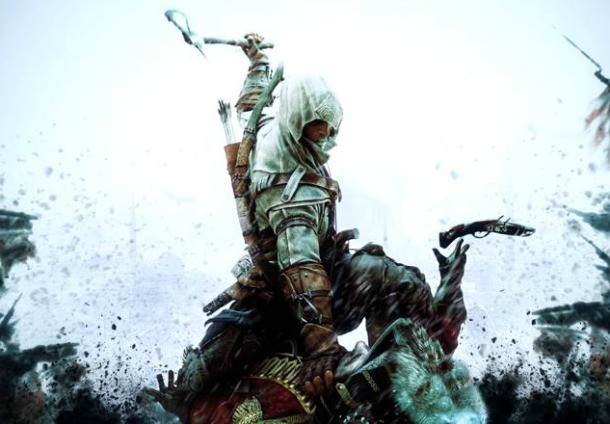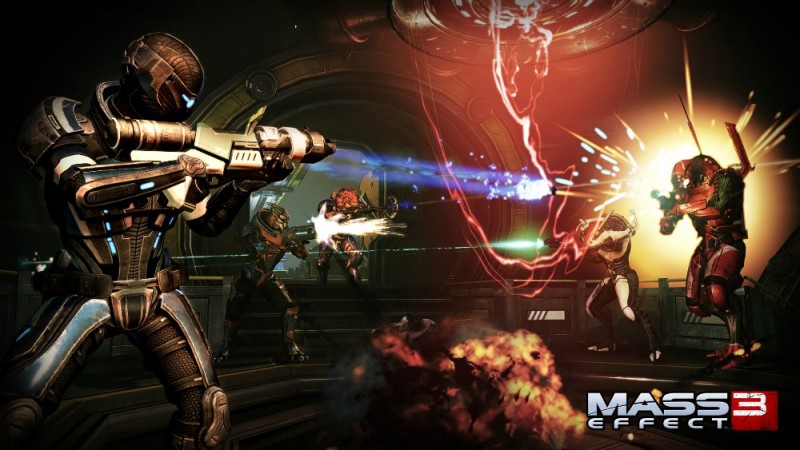Please support Game Informer. Print magazine subscriptions are less than $2 per issue
Single Player Is Dead, Long Live Single Player

At 2011’s European Game Developers Conference, industry veteran Mark Cerny rattled gamers’ cages when he told a room full of journalists he believes “the traditional single-player game experience will be gone in three years. Right now you sit in your living room and you're playing a game by yourself – we call it the sp mission or the single-player campaign. In a world with Facebook, I just don't think that's going to last."
Cerny’s prediction placed single-player gaming’s death at the end of 2014. These comments were said at a time when a good majority of developers were going out of their way to include multiplayer components into games. Even the strongest of the narrative driven adventure series (like BioShock, Singularity, Batman: Arkham, The Chronicles of Riddick, and Uncharted) invested significant development resources into multiplayer integration.
Gamers were flocking toward games like Call of Duty and Battlefield primarily for their multiplayer experiences. That was the “it” factor of the time. Multiplayer was king, and most publishers wanted in on the action. Stacked up to these juggernaut releases, a single-player shooter on its own seemed somewhat incomplete, no matter how good it was. That fallacy hung over the industry.
A day after Cerny made his remarks, another industry veteran, Keith Fuller, who was a contractor for Activision at the time, stoked the fire in an interview with CNN in which he stated, “What I've been told as a blanket expectation, is that 90 percent of players who start your game will never see the end of it unless they watch a clip on YouTube."
I remember talking to numerous game creators at Naughty Dog, Insomniac Games, and various other companies about player retention and finding ways to keep them engaged in single-player content, while simultaneously being tasked to create a unique hook for multiplayer. Sometimes this task fell onto the same development team of the core game, creating a mess of development from a studio ill prepared to dive into the online waters. The addition of multiplayer often affected the quality of the single-player game.
Other times the multiplayer component was developed by an external team, and didn’t match the vision or tone of the story-based content. I also remember hearing rumors of edicts being passed down to every developer working with giant publishers to incorporate connected functionality in their games. One developer, who wishes to remain nameless in this article, says it felt like his team was assimilated by the Borg.
In 2010, Electronic Arts appeared to be all in on online gaming. In an interview with Develop, EA Games’ label president Frank Gibeau took a calculated shot at single-player gaming when he said “I volunteer you to speak to EA’s studio heads; they’ll tell you the same thing. They’re very comfortable moving the discussion towards how we make connected gameplay – be it cooperative or multiplayer or online services – as opposed to fire-and-forget, packaged goods only, single-player, 25-hours and you’re out. I think that model is finished. Online is where the innovation is, and the action is at.”

If you look at Electronic Arts’ release schedule from 2012 up until now, it reads like a multiplayer-focused playbook. Almost every game has some kind of online component, even the least likely of subjects such as role-playing juggernauts Mass Effect 3 and Dragon Age: Inquisition. Visceral also implemented cooperative play into Dead Space 3.
In a 2010 video interview, Boss Key Productions’ Cliff Bleszinski, who was working on Gears of War 3 at the time for Epic Games, told Xbox 360 Achievements “The biggest mistake you can make as a developer right now would be to make a game that’s a six-hour experience that has no multiplayer. What happens is gamers [say] ‘I’ll rent it, or I’ll buy it used.’ You don’t want gamers to date your game; you want them to marry your game. The more positive reinforcement you can use to do that, the better. Everybody in the industry is trying to figure out what to do to mitigate used game sales.”
This is the time when downloadable content and season passes became the norm for online-focused games. The industry at large was invested in finding ways to keep discs spinning in gamers' systems. For annualized series like Call of Duty, this often meant a full year of add-ons that led up to the next release.
Not everyone was bearish on single player at the time. Bethesda Softworks largely ignored the industry’s trends and instead focused on making quality single-player experiences like the internally developed The Elder Scrolls V: Skyrim – an adventure players can sink hundreds of hours into – and Arkane Studios’ Dishonored, an exceptional stealth adventure. Both games, which only offered single-player content, were critically acclaimed and sold well.
Harvey Smith, Arkane Studios’ co-creative director, backed up the success of his title with strong words for the industry mindset in an interview with Gamesindustry.biz. “What people say each cycle is, 'Fill-in-the-blank is the new thing'” Smith said. “And if you're old enough, you remember when it was live-action video games. At another point it was MMOs. At another it was social games. At another it was multiplayer shooters. And none of those things are bad; they're all great. But what the reality seems to be is we keep adding types of games and finding new player groups for those. The market seems to be expanding. It seems like our attention focuses on the new thing, but in reality, there are still plenty of people that like a particular kind of game. Every time someone announces the death of the single-player game, something like The Sims or BioShock Infinite comes along and does different things well. So far we haven't capped out. It's not like DOTA fans are buying DOTA and not playing Skyrim, or buying Dishonored and therefore not buying Madden. I think there's a bunch of different audience types, and we haven't even hit the limit yet."
The push for multiplayer took center stage at the beginning of this new console generation. The PC market had found success in MOBAs and MMOs, and publishers saw the potential of adopting large-scale multiplayer experiences to console.
Although Microsoft’s desire for Xbox One to always be connected to the Internet was chanted to hell by gamers, many developers embraced the idea. Respawn’s highly anticipated shooter Titanfall took the biggest leap by shunning single-player completely.

Titanfall’s multiplayer-only focus became a hot topic for gamers and the press alike. The norm for gamers at the time was for a triple-A shooter to offer a full suite of modes for single player, multiplayer, and co-op. A release that honed in on just one element, yet retailed for the same price as the other games that offered more robust feature sets didn’t sit well.
Titanfall’s model, as controversial as it was, was an enormous success. Over 10 million people played it since launch. 2K Games adopted a similar model for the online 4v1 title Evolve, which again was scrutinized, but shipped over 2.5 million copies. Last year’s Star Wars Battlefront shipped more than 13 million units, but received similar flak for its lack of a campaign. Battlefront has always been a series that steered clear of significant narrative-based modes, but again, players assumed EA would adopt the feature set of DICE’s other popular FPS series, Battlefield. The state of console shooters was largely a negative talking point in 2015, not just for the number of modes, but the quality of the individual games. Battlefront didn’t offer enough content in its multiplayer offering, Evolve’s evolving season pass drew ire, and Call of Duty: Black Ops III, while doing great things in Zombies and competitive multiplayer, delivered a dud of a campaign (perhaps the worst in the series). The big shooter successes were Destiny: The Taken King, an expansion that delivered great, new content, but also served the purpose of smoothed out rough spots from the original game, and Halo 5: Guardians, a gargantuan effort that took big risks with storytelling, player movement, and game modes – even though those changes weren’t to everyone’s liking.
The year was instead silently dominated by single-player games, and the hint of publishers shying away from multiplayer integration in triple-A releases.
Lengthy role-playing games like Fallout 4 and The Witcher III: Wild Hunt were two of the most talked about and successful releases of the year. The Witcher III netted Game Informer’s Game of the Year and Reader’s Choice Awards. In a study conducted by ICO partners, it was the most talked about game in the media in 2015, and was the fifth most talked about game on Facebook behind FIFA 15, Mortal Kombat X, Fallout 4, and Batman: Arkham Knight. There was an undeniable hunger from gamers for sprawling open world adventures. Grand Theft Auto V’s mind-bogging sales, which crested over 60 million at the end of 2015, I assume are for the single player first, and multiplayer second.
Games like Rise of the Tomb Raider and Assassin’s Creed Syndicate, which previously offered multiplayer components, abandoned the connected world with each respective development team stating it was a move made to improve upon the single-player experiences. Konami’s decision to delay the versus component of Metal Gear Solid V: The Phantom Pain didn’t deter sales, but more so hinted at the publisher’s confidence in this mode, which has floundered since its launch late last year.
One of the biggest emerging storylines from this new generation of games has been the success of adventure games. This genre has new life, and game makers are flocking to it to experiment with different storytelling methods. Dontnod’s Life is Strange delivered spellbinding drama in a high school, and Supermassive Games’ Until Dawn showed us that the DNA of a campy slasher flick can transform into a thrilling choice-driven experience. While I haven’t played Toby Fox’s Undertale yet, people can’t stop gushing about this adventure/RPG hybrid, going as far to say it’s so good that they don’t want to say anything about it for fear of spoiling its surprises.
And let’s not forget about Telltale Games’ continued contributions to the genre. The technology fueling Telltale’s games becomes a little more antiquated with each new title, but the studio's expertise in storytelling has been proven time and time again. Tales from the Borderlands showed growth for the company, moving away from the Kleenex-grabbing drama of The Walking Dead formula for a more comedic and lighthearted journey.
Respected industry talent turned doomsday criers may have called for an end of days for single player, but they couldn’t have been more wrong. We don’t want to play exclusively in connected worlds – we want it all, the single player, the multiplayer, the VR experiences we can’t even comprehend yet, all of it. A good game is a good game – that’s what drives gamers, not trends. I hope the days of studios trying to cram a game into the same type of mold, even when the developers are saying it won't work, are behind us. The focus should be on wowing us and giving us something we love playing. When a developer says it's a mistake to make a story-driven game with no multiplayer components, it speaks more to those single-player experiences being creatively bankrupt than gamers not wanting that type of game again.










